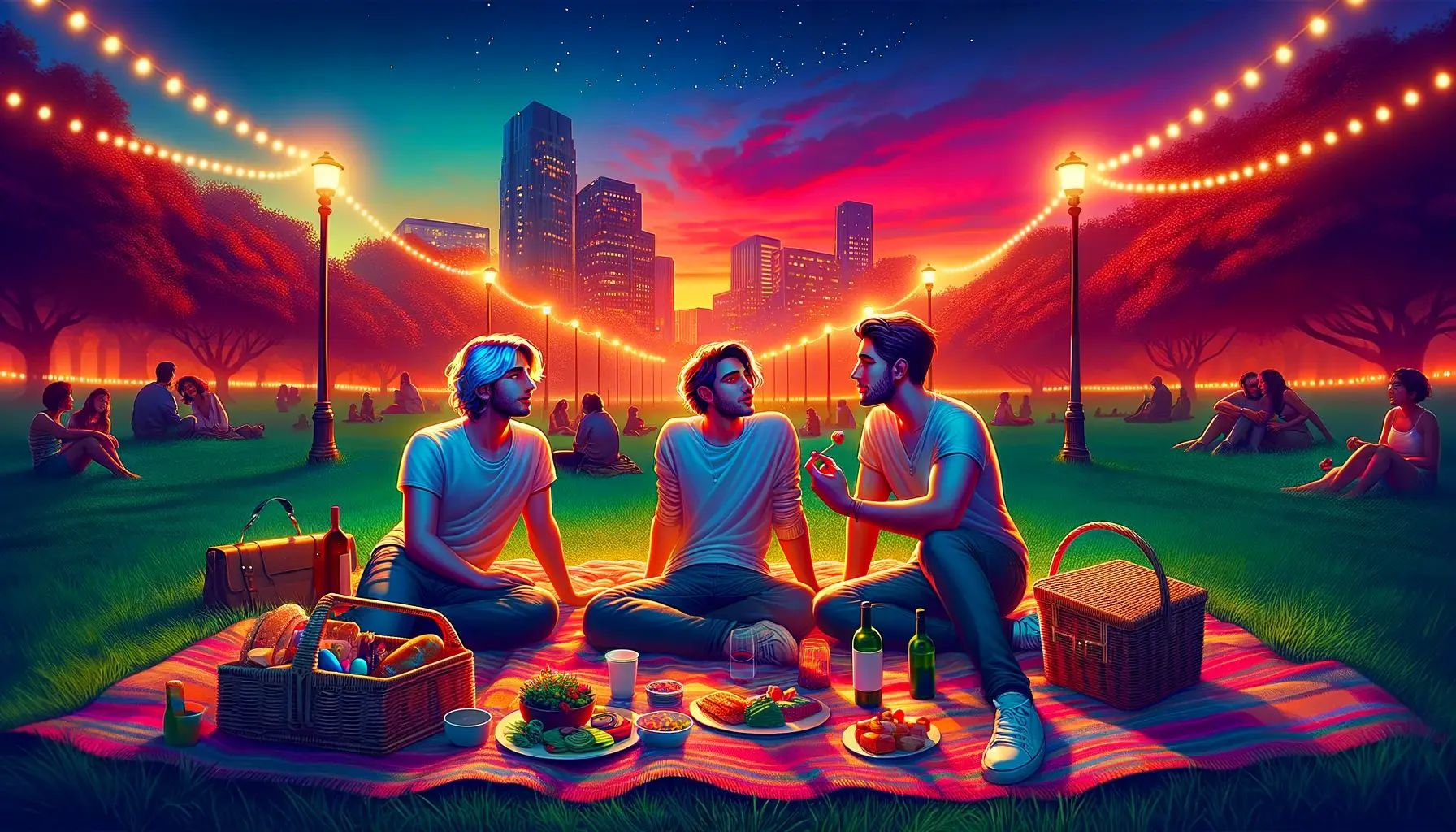Let’s discuss some popular and trending dating app terminology : Bisexual vs Pansexual vs Omnisexual. It’s crucial to familiarise ourselves with the diverse ways people identify their specific sexual orientation. Bisexuality, pansexuality, and omnisexuality, while often grouped together, each paint a unique picture of how individuals experience love and attraction.
This article is not just about terminology; it’s a deeper look into human connections that transcend traditional boundaries. Whether you’ve encountered these terms in conversations, media, or are navigating your own identity, this guide is designed to celebrate the differences, and foster a deeper understanding of these sexual orientations.

Defining the Terms: Bisexual vs Pansexual vs Omnisexual
Embarking on our journey into understanding human attraction, let’s start by laying the foundation with clear definitions. Understanding the nuances of each term is like unlocking the doors to a more inclusive and empathetic world.
What is Bisexuality?
Traditionally, bisexuality is understood as the attraction to two genders, typically men and women. However, the modern interpretation is far more encompassing. Bisexuality now refers to the potential for attraction to people of one’s own gender as well as other genders, not limited to just two. This evolution in understanding reflects the fluidity of bisexuality, embracing a wide range of attractions that are not strictly binary.
What is Pansexuality?
Pansexuality takes the inclusivity one step further by transcending the concept of gender in attraction. Pansexual individuals can experience a romantic or sexual attraction to people regardless of their gender identity or expression. It’s a testament to the idea that love and attraction are boundless, not confined by societal constructs of gender.
What is Omnisexuality?
Omnisexuality, while similar to pansexuality, incorporates an awareness and consideration of gender into its definition. Omnisexual individuals recognise and are attracted to all genders, but unlike pansexuality, gender plays a role in their attraction. It’s a distinction that highlights the complex interplay between gender and attraction for omnisexual people.
Exploring the Differences : Bisexual vs Pansexual vs Omnisexual
We will now explore the subtle yet significant differences between bisexuality, pansexuality, and omnisexuality. This discussion is not about labelling or boxing in human experiences, but rather about understanding the rich variety of ways people connect and find love.
Bisexuality: The Dual Path
Bisexuality is often depicted as attraction towards both men and women, but this definition barely scratches the surface. A more nuanced understanding acknowledges that bisexuality embraces attraction to more than one gender, not necessarily in equal measure, and not limited to just two genders. Bisexual individuals might find themselves drawn to various gender expressions but don’t necessarily feel attraction to all genders.
Pansexuality: The Boundless Love
Pansexuality steps into the realm of potential attraction to people of any gender identity. This orientation highlights the ability to form romantic or sexual connections with individuals regardless of their gender. For pansexuals, it’s the person’s essence – their personality, soul, or character – that sparks attraction, rather than their gender per se.
Omnisexuality: The Selective Spectrum
Omnisexuality, while similar to pansexuality in its inclusivity, brings its own unique flavour. Omnisexual individuals might feel attracted to all genders, but unlike pansexuals, they often recognise and appreciate the specific gender-related aspects of their attractions. There’s an awareness and acknowledgment of gender in their attraction, yet it doesn’t limit their ability to be drawn to any gender identity.
Common Questions and Misconceptions
A myriad of questions and misconceptions often arise when discussing the differences between bisexuality, pansexuality, and omnisexuality. Let’s address and debunk some of the most common of these, and shed light on the truths that foster understanding and acceptance.
Q1: Is bisexuality just a phase?
One pervasive myth suggests that bisexuality is merely a transitional phase between heterosexuality and homosexuality. However, bisexuality is a valid and enduring identity for many individuals. It’s not a stopover but a destination in its own right.
Q2: Aren’t pansexuality and omnisexuality the same thing?
While pansexuality and omnisexuality both recognise the potential for attraction beyond traditional gender binaries, they differ in nuances. Pansexuality is characterised by the potential for attraction to individuals regardless of gender, often focusing on personal connection over gender identity. Omnisexuality, while also inclusive, involves an awareness and appreciation of gender differences in attraction. The distinctions may seem subtle but are significant to those who identify with each term.
Q3: Do these orientations mean you’re attracted to everyone?
A common misconception is that identifying as bisexual, pansexual, or omnisexual means being attracted to every single person. Just like anyone else, individuals within these orientations have their own preferences, types, and non-negotiables. Their capacity for attraction is not indiscriminate but encompasses a wider spectrum of gender identities.
Q4: Are these terms just trendy labels?
Some may dismiss these identities as modern fads or unnecessary labels. However, these terms provide language for experiences and feelings that have existed across cultures and histories. They offer individuals a sense of community, understanding, and validation in a world that often demands conformity to narrow norms.

Why Understanding Matters
Understanding the distinctions between bisexuality, pansexuality, and omnisexuality is more than an academic exercise—it’s a step towards building a more inclusive and compassionate world. Here’s why truly understanding these identities and embracing their differences matters:
Fostering Inclusivity
Recognising and respecting the diverse ways people identify their sexual orientation paves the way for a more inclusive society. It allows everyone to feel seen and valued, not despite their differences, but because of them. Understanding these orientations dismantles barriers and builds bridges, making room for everyone to express their authentic selves.
Challenging Stereotypes
Stereotypes and misconceptions can lead to misunderstandings and prejudice. By educating ourselves and others about the nuances of bisexuality, pansexuality, and omnisexuality, we challenge and dismantle these stereotypes. This not only supports individuals within these communities but also enriches our collective understanding of the complexity of human attraction.
Encouraging Authenticity
When we acknowledge and celebrate the vast spectrum of sexual orientations, we empower individuals to embrace their true selves. Understanding that there are multiple ways to experience and express attraction can provide comfort and validation to those who may feel isolated or misunderstood within more traditional frameworks of identity.
Promoting Empathy and Connection
At its core, understanding these orientations is about cultivating empathy. By taking the time to learn about and appreciate the diverse experiences of others, we foster deeper connections. Empathy allows us to step into the shoes of another, to see the world through their eyes, and to connect on a profoundly human level.
Contributing to Mental Health and Wellbeing
Acceptance and understanding of diverse sexual orientations contribute to the mental health and wellbeing of individuals who identify with these labels. Feeling accepted and understood can significantly reduce feelings of isolation and anxiety, contributing to a healthier, happier society.

Celebrating the Sexuality Spectrum
By understanding the differences between bisexuality, pansexuality, and omnisexuality we open our hearts to the myriad ways love manifests. It’s a journey that challenges us to look beyond traditional binaries and embrace the complexity and beauty of human connection in all its forms.
Let’s carry forward the spirit of inclusivity, empathy, and understanding we’ve nurtured here. By celebrating individuality we contribute to a world that values and cherishes diversity. With understanding we find unity, not in sameness, but in the shared human experience of seeking love, acceptance, and connection.
In the end, it’s the diversity of our experiences that enriches our collective human story, painting a picture of a world vibrant with the colours of love in all its forms.

Meet Rick, Adultsmart’s owner with 35+ years in the adult industry. A sex blogger, advocate for gender and sexuality equality, offering a diverse product range.








Leave a Reply